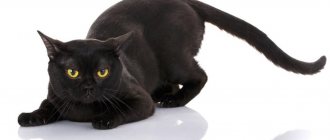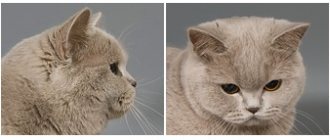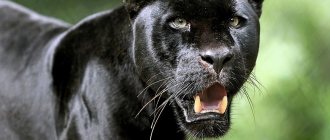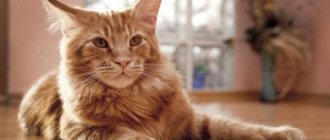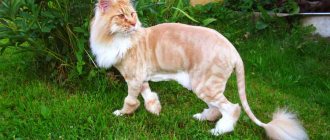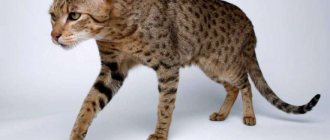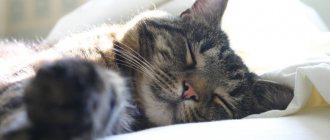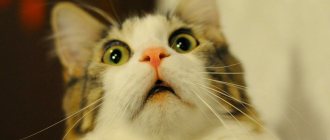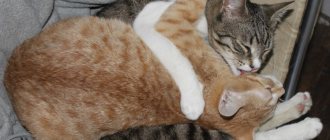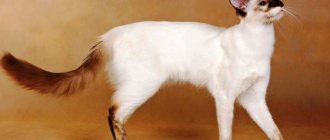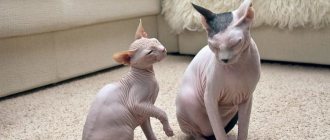The black Bombay cat has nothing to do with the ancient Indian city. She looks like a mini-panther, and owes her appearance to the crossing of two breeds - the Burmese and the American Shorthair. For superstitious people, this cat personifies something terrible, since its color from the tip of its nose to the pads on its paws is jet black. It is worth mentioning separately about the coat of the Bombay cat - its smoothness, shine and density, as well as its impenetrable ink color, are more reminiscent of patent leather than just short hair.
Americans even call representatives of the Bombay breed “shoe polish beauties with eyes like shiny copper coins.” Our compatriots, seeing this cat, will most likely exclaim in admiration: “Bagheera!”
Key facts
The Bombay cat is called the “miniature panther” because of its predatory grace. In the look of an animal one can read the wisdom of many generations. The mysterious appearance of the Bombay is captivating - there are no light hairs or spots of other shades in the varnished short coat of the color of a raven's wing. Kittens are sometimes born with small brown spots, but during the moulting process, before they are one year old, they disappear completely.
Bombays' eyes are first blue, then gray, until 3 years old they are yellow-orange, and after 5 years they acquire a green tint.
Bombays are adapted to life at home: they are smart, affectionate, playful, easy to train, and love their owner. Description of the Bombay cat breed combines the activity of the American Shorthair and the extroverted features of the Burmese cat. It is unlikely that there will be another representative of the cat family with the same grace and appearance as a real panther.
Despite their “wild” appearance, Bombays are distinguished by their friendly, accommodating character, affection and devotion to their owners, and tolerance of small children and dogs. The animals are very smart, easy to train, have excellent health, and are unpretentious in their daily care and nutrition. They adapt very quickly to the new environment.
Characteristics of the Bombay cat breed include the following facts:
- The country of origin is considered to be America, the 50s of the 20th century. The cat breed was bred in the state of Kentucky; fanciers set themselves the goal of getting a miniature copy of the graceful panther.
- The Bombay's personality traits are a cross between the sociable, affectionate, playful Burmese and the kind, balanced, calm, intelligent American Shorthair cat.
- Care does not cause any difficulties. Frequent combing or haircuts are not required.
- If well maintained, the life expectancy of a Bombay cat is 19 years. Bombays live on average 12-16 years.
They are incredibly loyal, people-oriented animals that love to be the center of attention. If you prefer peace, then such features of the breed will be more likely to hinder than please - so it is better to choose someone else.
Price
If we talk about the price of a Bombay cat, then the pleasure of owning such a breed will cost an average of sixty thousand rubles. Nurseries are currently able to offer a sufficient number of representatives of this rare species.
The main thing is that the trend of quality matching the indicated cost is clearly visible.
There are good nurseries in Kyiv, Minsk, and, of course, in Moscow. They provide exclusively purebred and healthy animals.
History of the origin of the Bombay cat
Bombays as a breed originated in the USA. In the fifties of the 20th century, Nicky Horner visited an Asian country and was delighted with black panthers. After returning home, she set herself the task of breeding a unique breed of cats that resemble graceful and flexible predators.
To achieve this, sable Burmese were crossed with American shorthair cats. The experiment took about 5 years, and only in the 4th generation did “mini-panthers” appear with black fur like a raven’s wing and shiny copper eyes.
The year of registration of the new breed of Bombay cat was 1958. The cat aroused the admiration of many American breeders, who happily began breeding elite animals. In 1977, Bombay cats took part in the world championship and took 1st place, after which they became popular throughout the world.
In the Russian Federation, Bombays are considered an elite - rare and expensive breed. There are only a few nurseries in the country where unique animals are bred.
History of the breed
In the 1950s, US breeder Nicky Horner, who adored the beauty and grace of wild felines, decided to create a breed that looked like panthers living in India. Selection activities continued for 20 years; Burmese and American shorthair cats were used for crossing.
Felinologists rejected the selection result, and the breed turned out to be unrecognized. Niki Horner gave up, but the initiative was taken up by the Zwecker breeder family. Selection work continued, the result was the appearance of the ancestor of the Bombay cat breed, nicknamed Luv It Black. In 1985, the cat was awarded second place in the ranking of CFA representatives.
What does a Bombay cat look like?
This is a medium-sized animal, elegant, graceful, predatory with black and shiny fur, large gold-colored eyes. By adulthood, the Bombay cat gains weight of 2.6-5.6 kilograms.
Muzzle
As you can see in the photo, the Bombay cat's head is medium, slightly rounded. The muzzle is wide, with a pronounced but neat transition to the forehead. The nose is short, the chin is strong, the cheeks are full, the ears are rounded at the ends and set wide apart, tilted forward. The large eyes shine, resembling two gold-plated coins.
Body type
Bombays have an elongated body and a wide chest. The cats' musculature is well developed, the skeleton is massive. The neck is thickened and arched.
The fore and hind limbs are proportional to the muscles. The paws are slender, the front paws have five toes, the hind paws have four.
Bombays have a straight, strong tail, proportional in length to the body. A tail that is too short, long or crooked is a sign of an unclean breed.
Muscular animals reach 32 cm at the withers, females in adulthood weigh 2.6-3.6 kg, and males weigh up to 6 kg.
Coat and color
The Bombay's calling card is its thick, short, glossy, close-lying coat. The color of the Bombay cat demonstrates the elite nature of the breed - the animal does not have a single light hair, from the nose to the paw pads it is completely black. The exception is large, shiny amber eyes. There is practically no undercoat, which is why Bombays are great for people prone to allergies to wool.
There are 2 varieties of Bombay cats - British and American, which have a number of characteristic differences:
- “British” - representatives of the Burmese cat breed of the Asian group, obtained by crossing pets with characteristics similar to the Burmese cat;
- “Americans” are a mix of Burmese and American Shorthair cats.
British women's eyes are amber or yellow, American women's eyes are copper or dark orange. Bombay kittens are born with gray or blue eyes that turn copper or amber by 6 months.
Description
Since the Bombay cat was bred relatively recently, not everyone knows what it looks like. Often a completely mongrel animal that bears only a vague resemblance to it is passed off as a purebred Bombay. To avoid falling into the hands of scammers, you should purchase kittens only from specialized nurseries, and we will tell you what a Bombay cat looks like, give a description of the breed and some tips on choosing a kitten.
Appearance
Externally, the Bombay cat is very similar to the Burmese. Yes, this is understandable, since both breeds are related. The same elegance of gait, the same grace. However, there are a number of differences - the body is noticeably more elongated, the paws are thinner, the stop is less pronounced.
The Bombay wool resembles the Burmese only in its silkiness. It fits tightly to the animal's body and has a bluish-black color. No inclusions of white or other colors are allowed.
According to the breed standard, the Bombay cat also has the following distinctive features:
- the body is muscular, medium in size;
- wide chest;
- straight tail;
- the head is small, round in shape with a clear stop;
- ears are rounded at the tips, medium in size;
- the eyes are large, round, bright amber in color;
- black nose and paw pads.
You can see more clearly what a Bombay cat looks like in the photo below.
The Bombay cat's calling card is its jet-black, satiny coat.
There is also a British breed standard. It is somewhat different from the generally accepted American one. British Bombay cats are distinguished by their slender body build. They have green and yellow eyes.
Character
Despite the appearance of the formidable Bagheera, the Bombay cat is quite peaceful. She gets along with almost all other pets. She inherited curiosity and playfulness from the Burmese. However, there is no need to be afraid of her activity. From her American Shorthair ancestor she also inherited a balanced character and graceful manners.
The Bombay cat is easy to communicate with. She is sociable and does not tolerate loneliness well. These cats often choose one family member as an object of adoration and sleep only next to him. They resemble dogs in their devotion.
As a rule, they treat children well, but they do not like to be squeezed and dragged around. To a child who respects her, she will become a true friend.
Bombay cats have extraordinary intelligence. It is easy to teach them different tricks, which she will be happy to perform. They usually learn the rules of behavior in the house the first time and strictly follow them throughout their lives.
How to choose a kitten?
A Bombay kitten should only be purchased from specialized nurseries with a good reputation; this is the only way to avoid being scammed. When purchasing, check the metrics and veterinary passport. If you are taking a kitten for breeding, make sure that the mother's pedigree does not include a mark such as a craniofacial defect, which is often found in Bombay cats.
Small kittens may have a mixture of brown or gray hairs and blue eyes. They will acquire their true color only after four months. You can judge what a pet will look like from the appearance of its parents, so ask the breeder to show them to you.
It will not be superfluous to examine the kitten for existing diseases. A healthy baby has shiny, clean fur, without black spots or scratches. The eyes are wide open, brilliant in color, without redness or discharge. He actively reacts to what is happening, when you try to pet him, he does not try to bite or scratch you. The tummy should be soft and the nose should be cold and dry.
Little Bombays bear little resemblance to their parents: they have blue eyes and spotted coats.
Bombay cat personality
Bombays combine the balanced, calm disposition of the American Shorthair cat and the sociability and playfulness of the Burmese cat. The Bombay cat's personality is friendly, docile and loyal. Many pet breeders note that miniature panthers can make any person fall in love with their pleasant manner of communication, shiny coat and eyes glowing with amber light. Bombays require increased attention, do not tolerate loneliness, love affection, and are constantly near the breeder.
These cats are the first to run towards people entering the house, because they are sure that they have come to visit them. Bombays are active and incredibly curious: they explore the world around them with great pleasure, rarely giving up outdoor games. They respect all family members and get along well with children and dogs.
Character and behavior
The Bombay cat is a very balanced and peaceful creature. From her ancestors she inherited such traits as restraint, calmness, non-conflict and contact. All family members are her best friends. She does not single out a leader for herself, but on the contrary, she herself strives to take the dominant place in the house, but she does this very gently and unobtrusively.
She is quite a talkative person: her voice is an opportunity to convey her desires to others and share her problems. Females are more “chatty”, and their purring is much more melodic and gentle than that of males.
They get along well both in an apartment and in a private house. They don’t need a lot of space, but their own play corner is desirable. Buy a small play complex with pipes and shelves of different heights - this will be quite enough. In the warm season, it is advisable to take the animal for a walk. If you teach your pet to use a leash from early childhood, you will not have problems in the future.
Name the cat who always wanted to live together
BasilioLeopold
Bombay cats quickly establish contact with other cats and dogs, sometimes even becoming truly friends. But birds and small rodents are prey for them, so don’t be surprised why your cat sits for hours near a cage with a parrot, not taking its eyes off it.
Cats of this breed are lenient towards children: they can tolerate pranks for quite a long time, but at a certain moment they can crack their paws.
Bombays always run to meet guests, but at first they treat them very, very warily: after sniffing their hands, they won’t allow themselves more. And if a person has bad intentions, they will immediately feel it and will behave even more carefully and may show aggression: start hissing at the guest and hiding from him in a secluded corner.
Young Bombay residents are very inquisitive and love to stick their satin nose into all the nooks and crannies of their home, but with age they become more sedate, choosing an observation post somewhere on the windowsill or the back of the sofa, and observing those around them from there.
Raising a Bombay cat
Cats are naturally obedient. The authority of the owner is important to them, so they completely obey him and try not to make him angry or upset again. They are distinguished by caution, attention and gentle manners. Even in a game, Bombays will never break a fragile object located on the edge of the table. But much in such matters depends on the correct upbringing of the Bombay cat, which should be worked on from the first days the pet appears in the house.
Accustoming a kitten to your hands will not be difficult, since the animal loves tactile contact. But you shouldn’t play with the little “panther” with your hands - a predatory cat can scratch and bite them. It is better to use feathers or sticks with ribbons as toys. Leave your hands for encouragement - stroking and similar tenderness for obedience and good behavior.
No less attention should be paid to training the kitten to use the litter box. When he “does it” in the wrong place, the problem can be solved in 2 ways:
- The “crime scene” is thoroughly washed with strong-smelling solutions without chlorine (for example, vinegar) or special compounds that can be purchased at a pet store - this should scare away the animal and make it stop coping in the wrong place;
- the tray is placed in the place where the bombay is accustomed to relieve itself, and gradually moves (3-5 cm per day) towards the future location.
Punishments are also appropriate, but they cannot be harsh and severe. Spraying the offending animal with water has worked well. The reaction must be immediate - no later than 10 seconds after the offense. Otherwise, the pet may not understand the cause-and-effect relationship and may even harbor a grudge against the person.
Mr. Cat recommends: proper nutrition and health
It is enough to feed the Bombay 2-3 times a day, doing it at the same time. For this breed it is better to use premium dry food. A combination diet will not work, although you can sometimes pamper your cat with steamed lean meat. At the same time, the Bombay loves to eat, and if its diet is not controlled, it gains weight and becomes slow and lethargic.
You need to monitor the portions and vitamins that the animal receives. Protein should make up at least 80% of the daily diet, and it is better to allocate up to 20% for fiber. Don't forget that cats need vitamins. Specific medications are prescribed by a veterinarian; it is worth consulting with him on this issue.
Due to the characteristic structure of the nasopharynx (the absence of a clear transition between the forehead and nose), Bombays are characterized by diseases associated with the respiratory system and increased lacrimation. Such an animal is not allowed to be exhibited.
Bombay cat health
Bombay cats are naturally healthy and with proper care can live up to 16 years. But, like other animals, they can get sick.
Possible diseases
Unfortunately, even vaccinated and healthy pets from birth are not immune from various ailments. For Bombays, the following may occur:
- Common problems are: gum disease, respiratory failure, hypertrophic cardiomyopathy, accompanied by rapid heartbeat and shortness of breath. Such ailments require immediate contact with a veterinarian: proper treatment will alleviate the animal’s condition and prolong its life.
- A runny nose and lacrimation appear in an animal due to the specific structure of the nose. Solutions and drops prescribed by a veterinarian completely solve the problem in 3-5 days.
- Because cats have an excellent appetite, they often suffer from digestive disorders and obesity. You need to feed your pet a balanced diet according to the recommended standards.
It is important to give your pet all the necessary vaccinations on time and to constantly perform antihelminthic prophylaxis - and then the health of the Bombay cat throughout its life will not be a cause for concern.
Reproductive health
Breeding Bombays is an art. The first estrus in females begins at 6-8 months and lasts 5-7 days. If during this time the Bombay cat does not become pregnant, estrus repeats after 2 weeks. Professional breeders recommend performing the first mating no earlier than 1 year of age; the best time for this is the fourth day of estrus.
No less attention is paid to choosing a partner. The owner needs to determine for himself: he wants to satisfy the natural needs of the animal or continue the family of a purebred pet. In the second case, you will need an “ideal groom,” which means you will have to search for an experienced breeder or a cattery with clean cats. Veterinarians recommend giving birth no more than once a year, otherwise the female’s body will weaken, she will become thin, and her immunity will begin to fail.
If you do not plan to breed a cat, castration is required - an operation to remove the genitals. During sterilization, the veterinarian only ties the fallopian tubes - hormones continue to be produced, and sexual desire is preserved. After castration, the pet becomes more balanced and calm, its reproductive system is completely protected from the development of diseases.
Surgery is performed by a surgeon in specialized clinics. The cat is not fed for a day; it is brought in advance, after which the doctor takes all the necessary tests. Abdominal surgery is performed under general anesthesia.
Puberty, mating
Bombay cats reach sexual maturity at 6–9 months, although by this time the body and organism are not yet fully formed. Final development occurs only by two years - this is a very decent period. Despite this, some cats give birth as early as 5 months. If mating is not planned, it is better to resort to castration and sterilization; the procedure is carried out in the 6–9th month of the pet’s life.
Mating is carried out on the territory of the male. The Bombay cat's pregnancy lasts 63–70 days from the moment of mating. There are rarely more than four kittens in one litter.
There are rarely more than four kittens in one litter
Features of feeding and diet
Bombay kittens eat a lot. It is better to buy them balanced food with additives and nutrients.
If you prefer natural feeding, you should include in your pet’s diet:
- oatmeal, buckwheat, wheat porridge;
- quail, chicken raw yolk;
- offal;
- beef, veal;
- dairy products;
- sea fish without bones;
- vegetables (eggplant, carrots, zucchini).
Important! A complete Bombay diet should include 80% protein and 20% everything else.
How to choose?
Bombay cats are considered quite rare representatives of their species. Not in every city you can find a nursery that sells these animals. Therefore, they are in high demand in the market among pet lovers. It is worth considering that under such conditions the cost of cats will be high. The price depends on the gender, age, qualities of the pet and its prospects.
In order to choose a good pet, you need to go through several stages:
- find the necessary nursery;
- study detailed information about the nursery and the Bombay breed;
- pre-arrange a meeting with the breeder;
- go to the nursery and choose a cat.
Once you have chosen the right kitten, it is recommended that you pick it up. This way you can find out the animal’s character and health status. Bombay should not scratch or bite, this shows his aggressive attitude. Such kittens will take a long time to adapt to new conditions and communication with household members. If the pet has already had owners, then this behavior indicates a rude attitude towards it, which provoked fear of new people.
You should carefully examine the Bombay black cat. The ears should be clean, the same goes for the nose. Be sure to check the animal’s eyes; there should be no “nitrous” in them; their presence may indicate poor health of the cat. The pet's coat should be smooth and shiny. No wounds on the body are allowed. An exception may be scratches on the animal's neck. Usually such damage is left by mother cats after dragging a kitten. Don't forget to inspect the animal for various insects.
Be sure to pay attention to the kitten's breathing. It should be clean, without any wheezing
When choosing a pet, you also need to pay attention to the living conditions of the animal. The enclosure must be clean. The same applies to the animals themselves. If kittens have a litter box, they are most likely already potty trained. Before buying a Bombay kitten, it is advisable to look at the mother cat. She should not look sickly, her coat should be shiny, and her eyes should be rich in color and clear.
When the choice is made, you need to negotiate the cost of the pet, and then proceed to inspect its documents. An animal passport must be available, which contains information about vaccinations and diseases. The passport also contains information about operations, if any.
Care and maintenance
If you got a Bombay for home, and not for exhibitions or breeding, then the waste of time and effort will be minimal. Otherwise, caring for and maintaining a Bombay cat will require a more careful approach. You definitely need a rubber brush for carding wool and a special shampoo, as well as teeth cleaning supplies.
A common eye problem in Bombay - increased lacrimation - can be eliminated with rinsing solutions, which are sold in a regular pharmacy. You can also use a cotton swab dipped in weak black tea.
Bombay cats do not like walks in the fresh air - extraneous sounds make them anxious. The most comfortable environment is in a home where pets feel completely protected.
Toys for miniature “panthers” should be as safe and bright as possible; hanging tunnels and labyrinths will not be superfluous.
Description
Unlike the panther, Bombay cats are less impressive in size; the weight of the animals can vary from 2 to 5 kilograms. At the same time, the animals look quite elegant, and their movements have a slight grace.
- Body type. Representatives of this cat breed have massive shoulders and a powerful chest. Their body is slightly oblong. The muscles are well developed and very strong. The neck is large, slightly arched in appearance. Bombay cats have small, rounded paws. The tail of pets is medium in size and tends to taper towards the tip.
- Appearance. The small head of the Bombay has a rounded shape. A characteristic difference is the wide muzzle. The animal's cheeks are plump and its nose is small. The pet's chin is quite strong. The Bombay cat's ears are directed forward, they are very large in size and are located at a great distance from each other. Their tips are rounded. Pets' eyes are very large, usually painted in a golden or copper tint.
- Voice. Representatives of this breed are distinguished by their sociability, they have a singing, low timbre of voice. Due to this feature, frequent meowing rarely causes irritation among owners.
- Wool. Externally, the fur of the black Bombay cat resembles luxurious satin fabric. Short hairs fit tightly to the body of the animal, there is no undercoat.
- Color. All representatives of this breed have a rich black color, there are no exceptions.
- Lifespan. Bombay cats live from 12 to 20 years.
- Puberty. Animals grow up very quickly and become sexually mature by five months; later they are recommended to be sterilized. Physical development continues in cats up to two years.
It is worth noting that these pets are very sociable and friendly. Bombays fit well into the family, they quickly adapt to new living conditions and are very developed intellectually.
Tips for choosing a kitten
It is better to buy a fully formed 16-week-old Bombay, since up to this age kittens have blue eyes and brown coat color. It is simply impossible to guess what they will become. For this reason, exhibition specimens are purchased closer to the age of 5-6 months.
- Preference should be given to specialized nurseries, where the pet receives all the necessary documents (including a veterinary passport with vaccinations and birth certificate).
- Private breeders often turn out to be unscrupulous people who claim that their Bombay kittens have a pedigree, but in fact they turn out to be ordinary yard cats.
- No less attention should be paid to external indicators: the ears should be clean, the eyes should be clear, the tail should be even, without kinks, the coat should have a satin sheen, the kitten should be active in play.
Be prepared for the fact that this is a “companion” who will always be close to his breeder. If you like loneliness, it is better to give preference to another breed.
Catering
Bombays love to eat and lick their bowls until they shine. But too much food will turn from an elegant and graceful animal into a clumsy bun, suffering from shortness of breath, palpitations, diabetes, or worse. Therefore, remember the following:
- The cat must not be overfed! Adult animals (over six months old) eat 2 times a day: morning and evening. An exception can be made for lactating and pregnant females, sick or elderly animals. Teenagers 4-6 months eat 3-4 times, babies – 5-6.
- The animal should be switched to a new food gradually, and not suddenly change the diet. Apart from indigestion, this will not bring any benefit.
- You cannot mix natural food and ready-made food: choose one.
- Your cat should have separate bowls for water and food. It is advisable to wash the dishes after each meal so that they do not stagnate and become saturated with an unpleasant odor.
- Be sure to clean drinking water from harmful impurities and chlorine. A regular faucet filter will help with this. Or you can leave the liquid in a jar without a lid for 8-12 hours in a dark place.
Natural products
The following natural products are allowed:
- Meat. Only low-fat varieties: rabbit, turkey, veal, beef. The meat is pre-frozen, and before feeding it is thawed and doused with boiling water to destroy possible parasites. They feed the meat every day, cutting it into pieces 1-2 cm long. Fat layers, bones, and skin are removed. The exception is chicken necks: they are ground into minced meat along with cartilage.
- Fish. Salmon families: chum salmon, pink salmon, salmon, river trout. Or lean (if the cat is on a diet): blue whiting, cod, hake. All sharp parts, bones and fins must first be removed. It is also undesirable to give heads and milk. The fish is boiled for at least 20 minutes in unsalted water and given once a week. More often it is impossible - excess fish leads to the development of urolithiasis.
- By-products. This is an additional source of minerals and vitamins. Liver, hearts, ventricles - boiled or raw.
- Dairy products. Low-fat cottage cheese, natural yogurt without dyes and other additives, kefir, fermented baked milk, yogurt, low-fat sour cream.
- Eggs. Chicken ones are boiled and only the yolk is given to the cat (the protein gives the cat diarrhea), quail ones are fed whole.
- Porridge. Buckwheat, rice, oatmeal, barley. Porridge can be included in the diet when the kitten is 1.5 months old: first they are cooked in milk, and then in vegetable or meat broth. You can feed porridge every other day in the proportion of one part porridge to 3 parts meat.
- Vegetables. No more than 10% of the daily food intake. Zucchini, carrots, broccoli, asparagus, green beans, celery, beets. You can’t give them raw ones – the cat might choke! The exception is cucumbers and melons. They perfectly quench thirst. The hard skin can be removed.
It is prohibited to give:
- Pork and pork by-products (contains histamines), goose, duck and lamb (poorly digested), fresh liver and raw lung (causes diarrhea and vomiting), minced meat from the store (it often contains skin and fat);
- Corn, pea, millet porridge, semolina (it is acceptable to feed babies liquid semolina porridge with milk), instant porridge;
- Avocado, garlic, onions, grapes, raisins (and dried fruits). Potatoes cause constipation, so you should be careful with them;
- Sweet, smoked, salty, flour, baked goods;
- Dog food;
- Human vitamins;
- Tea, coffee, cocoa, whole cow's milk, mineral and sparkling water, juices, compotes.
Recommended food
Among industrial feeds, holistic and super-premium class feeds are considered the best. These are Fitmin Purity, Go Natural, Arden Grange. The rest - food from the economy and premium groups - are made from meat waste (rather than pure meat), contain chemical preservatives, dyes and flavor enhancers, which, naturally, will not benefit the cat.
Below are the recommended holistic and super-premium foods. Links with the names of the food are clickable, on them you can, within our website, get acquainted with the descriptions of the food and read reviews from the owners of the Bombay cat breed.
| Holistic | Holistic | Super premium |
| Canagan | Gather | Bozita |
Grooming
In general, the Bombay's fine and short coat does not cause problems. It is enough to comb the animal once a week with a rubber brush to remove lost hairs. Some pets get great pleasure from this, believing that they are simply being caressed and stroked. Some owners of a black Bombay cat additionally “polish” it with a suede cloth. It easily removes stuck dust particles from the fur, giving it an incredible shine.
The coat requires special attention only during the first molt. It starts at about a year old. The owner’s task is to help the young mini-panther get rid of its teenage brownish fur. Careful and frequent brushing will help you quickly achieve a flawlessly black silk robe.
As for swimming, the Bombay is calm about water procedures if he is accustomed to them from childhood. It is recommended to wash such cats once a month using special shampoos. Usually the signal for taking a bath is dull fur.
Activity
The Bombay cat is a very active, nimble and self-confident animal. It loves to get attention, poke its nose in and have fun in every possible way. Therefore, the pet must be provided with a large number of toys. Particular attention should be paid to devices for the development of intelligence and physical activity (labyrinths, cat trees, etc.).
Mini panthers love to spend time with their owner. Therefore, they get great joy from playing together and learning tricks. Of course, such a pet will not be able to bring slippers in its teeth, but smaller things are easy.
Bombay cats also have a well-developed hunting instinct, despite their aristocratic appearance and grace. These amazingly active and dexterous animals are excellent at catching mice when necessary. Some individuals even eat them with pleasure.
Historical reference
The “named mother” of the breed, an American from Kentucky, Nikki Horner, was a reputable breeder even before the Bombay cat was born. Nikki's track record included champions of the Siamese, Burmese, Himalayan, Persian, Exotic and American Shorthair breeds. Knowing “her” breeds, the woman suggested that a cat with the body of a Burmese and the black coat of an American Shorthair would be very similar to a wild panther.
Without thinking twice, Nikii crossed her Burmese cat with a sable color and an American Shorthair cat with a “tar coat.” The litter produced black kittens, but they did not match the description that the breeder wanted. The desired phenotype was obtained only in the 4th generation of the future breed.
The events described above took place in the 1950s. Numerous new breeds appearing during this period delayed the recognition of the Bombay cat by 23 years. Nikki Horner made a desperate attempt and filed documents for recognition of her brainchild in 1958. Experts did not recognize the Bombay cat as a new breed; more precisely, the animals were dubbed “underdeveloped” and “flat” American Shorthairs.
To the general joy of Burmese breeders, Nikki was forced to admit defeat and start work almost from the beginning. Based on experience, the woman more carefully selected parents for mating and in 1965 received the desired result. After carrying out several more matings and making sure that the breed's qualities were fixed, Nikki Horner again submitted a petition for recognition. Despite fierce resistance, in 1970 the breed standard was included in the register, and in 1976 the Bombay cat received CFA champion status and a path to the big world.
The 23-year-long struggle exhausted Nikki Horner and crossed the “finish line.” However, the breed has already gained its circle of admirers and the work to consolidate the standard was taken up by a group of breeders, led by the married couple Herb and Suzanne Zwecker. It was during this period of work that a turning point occurred, which deprived the breeders of Burmese cats of the right to protest. One of the litters gave birth to the female Luv It Black, who received the status of the second best breeding cat in the CFA competition.
Despite the small population, thanks to Love It Black, the Bombay breed was recognized by almost all authoritative felinological organizations:
CFA – Cat Fanciers Association.
WCF - World Cat Federation.
ACF – Australian Cat Federation.
TICA - International Cat Association.
ACFA - American Cat Fanciers Association.
The slightly “savage” motives of people led to the rise in popularity of the Bombay cat, because the black graceful predator looks so impressive in a modern interior. The breed is still in the stage of active development, is rare and expensive. The main task of breeders is to increase the number and popularize mini-panthers in the world. In order to speed up the process, the rules allow interbreed matings with sable “Burmese” and black American Shorthair cats.

